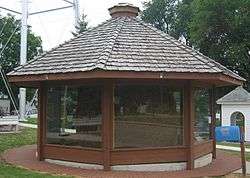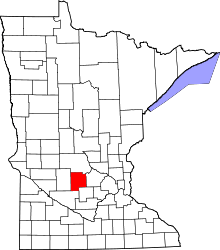Darwin, Minnesota
| Darwin, Minnesota | |
|---|---|
| City | |
 Location of Darwin within Meeker County, Minnesota | |
| Coordinates: 45°5′46″N 94°24′20″W / 45.09611°N 94.40556°W | |
| Country | United States |
| State | Minnesota |
| County | Meeker |
| Area[1] | |
| • Total | 2.15 sq mi (5.57 km2) |
| • Land | 1.99 sq mi (5.15 km2) |
| • Water | 0.16 sq mi (0.41 km2) |
| Elevation | 1,129 ft (344 m) |
| Population (2010)[2] | |
| • Total | 350 |
| • Estimate (2012[3]) | 342 |
| • Density | 175.9/sq mi (67.9/km2) |
| Time zone | Central (CST) (UTC-6) |
| • Summer (DST) | CDT (UTC-5) |
| ZIP code | 55324 |
| Area code(s) | 320 |
| FIPS code | 27-14842[4] |
| GNIS feature ID | 0642644[5] |
Darwin is a city in Meeker County, Minnesota, United States. The population was 350 at the 2010 census.[6]
It is one of several places claiming to be home of the largest ball of twine in the world.[7]
History
Darwin was platted in 1869, and named for E. Darwin Litchfield, a railroad official.[8] A post office has been in operation at Darwin since 1869.[9]
Geography
According to the United States Census Bureau, the city has a total area of 2.15 square miles (5.57 km2), of which 1.99 square miles (5.15 km2) is land and 0.16 square miles (0.41 km2) is water.[1]
Demographics
| Historical population | |||
|---|---|---|---|
| Census | Pop. | %± | |
| 1880 | 56 | — | |
| 1920 | 132 | — | |
| 1930 | 156 | 18.2% | |
| 1940 | 224 | 43.6% | |
| 1950 | 273 | 21.9% | |
| 1960 | 273 | 0.0% | |
| 1970 | 361 | 32.2% | |
| 1980 | 282 | −21.9% | |
| 1990 | 252 | −10.6% | |
| 2000 | 276 | 9.5% | |
| 2010 | 350 | 26.8% | |
| Est. 2015 | 352 | [10] | 0.6% |
2010 census
As of the census[2] of 2010, there were 350 people, 139 households, and 91 families residing in the city. The population density was 175.9 inhabitants per square mile (67.9/km2). There were 153 housing units at an average density of 76.9 per square mile (29.7/km2). The racial makeup of the city was 96.9% White, 0.3% African American, 0.3% Asian, 1.4% from other races, and 1.1% from two or more races. Hispanic or Latino of any race were 3.4% of the population.
There were 139 households of which 30.9% had children under the age of 18 living with them, 57.6% were married couples living together, 2.9% had a female householder with no husband present, 5.0% had a male householder with no wife present, and 34.5% were non-families. 25.2% of all households were made up of individuals and 8.6% had someone living alone who was 65 years of age or older. The average household size was 2.52 and the average family size was 3.10.
The median age in the city was 38.7 years. 24.3% of residents were under the age of 18; 7% were between the ages of 18 and 24; 27% were from 25 to 44; 27.5% were from 45 to 64; and 14.6% were 65 years of age or older. The gender makeup of the city was 51.7% male and 48.3% female.
2000 census
As of the census[4] of 2000, there were 276 people, 119 households, and 79 families residing in the city. The population density was 368.7 people per square mile (142.1/km²). There were 130 housing units at an average density of 173.6 per square mile (66.9/km²). The racial makeup of the city was 92.03% White, 0.72% African American, 5.80% from other races, and 1.45% from two or more races. Hispanic or Latino of any race were 5.07% of the population.
There were 119 households out of which 31.1% had children under the age of 18 living with them, 54.6% were married couples living together, 9.2% had a female householder with no husband present, and 33.6% were non-families. 29.4% of all households were made up of individuals and 14.3% had someone living alone who was 65 years of age or older. The average household size was 2.32 and the average family size was 2.84.
In the city the population was spread out with 27.2% under the age of 18, 6.9% from 18 to 24, 25.0% from 25 to 44, 25.0% from 45 to 64, and 15.9% who were 65 years of age or older. The median age was 38 years. For every 100 females there were 97.1 males. For every 100 females age 18 and over, there were 97.1 males.
The median income for a household in the city was $34,286, and the median income for a family was $37,321. Males had a median income of $31,000 versus $22,500 for females. The per capita income for the city was $16,813. About 6.0% of families and 10.2% of the population were below the poverty line, including 17.1% of those under the age of eighteen and 8.5% of those sixty five or over.
Parks and recreation

Darwin is the home of Darwin–Dassel Park.
The Twine Ball Museum is located at Darwin.
Infrastructure
Transportation
U.S. Highway 12 serves as a main route in the community.
References
- 1 2 "US Gazetteer files 2010". United States Census Bureau. Retrieved 2012-11-13.
- 1 2 "American FactFinder". United States Census Bureau. Retrieved 2012-11-13.
- ↑ "Population Estimates". United States Census Bureau. Retrieved 2013-05-28.
- 1 2 "American FactFinder". United States Census Bureau. Retrieved 2008-01-31.
- ↑ "US Board on Geographic Names". United States Geological Survey. 2007-10-25. Retrieved 2008-01-31.
- ↑ "2010 Census Redistricting Data (Public Law 94-171) Summary File". American FactFinder. U.S. Census Bureau, 2010 Census. Retrieved 23 April 2011.
- ↑ Twisted: The Battle to Be the World's Largest Ball of Twine; The Atlantic; September 9, 2014.
- ↑ Upham, Warren (1920). Minnesota Geographic Names: Their Origin and Historic Significance. Minnesota Historical Society. p. 339.
- ↑ "Meeker County". Jim Forte Postal History. Retrieved 21 July 2015.
- ↑ "Annual Estimates of the Resident Population for Incorporated Places: April 1, 2010 to July 1, 2015". Retrieved July 2, 2016.
- ↑ "Census of Population and Housing". Census.gov. Retrieved June 4, 2015.
External links
| Wikimedia Commons has media related to Darwin, Minnesota. |
Coordinates: 45°05′47″N 94°24′39″W / 45.09639°N 94.41083°W
